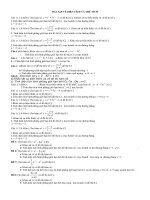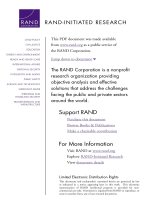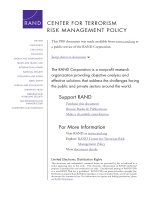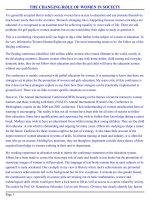Dessler HRM 12e ch 03 the managers role in strategic HRM
Bạn đang xem bản rút gọn của tài liệu. Xem và tải ngay bản đầy đủ của tài liệu tại đây (1.47 MB, 45 trang )
Chapter 3
The Manager’s Role
in Strategic Human
Resource Management
Part One | Introduction
Copyright © 2011 Pearson Education, Inc.
publishing as Prentice Hall
PowerPoint Presentation by Charlie Cook
The University of West Alabama
WHERE WE ARE NOW…
Copyright © 2011 Pearson Education, Inc. publishing as Prentice Hall
3–2
LEARNING OUTCOMES
1. Explain why strategic planning is important to all
managers.
2. Outline the basic steps in the management planning
process.
3. List the main contents of a typical business plan.
4. Answer the question, “What should a manager do to set
‘smart’ motivational goals?”
5. Explain with examples each of the seven steps in the
strategic planning process.
6. List with examples the main generic types of corporate
strategies and competitive strategies.
Copyright © 2011 Pearson Education, Inc. publishing as Prentice Hall
3–3
LEARNING OUTCOMES (cont’d)
7. Define strategic human resource management and give
an example of strategic human resource management
in practice.
8. Briefly describe three important strategic human
resource management tools.
9. Explain with examples why metrics are essential for
identifying and creating high-performance human
resource policies and practices.
Copyright © 2011 Pearson Education, Inc. publishing as Prentice Hall
3–4
Why Strategic Planning Is
Important
To
All
Managers
• The
firm’s strategic plan guides much of what is done by
all to accomplish organizational goals.
• Decisions made by managers depend on the goals set at
each organizational level in support of higher level goals.
Copyright © 2011 Pearson Education, Inc. publishing as Prentice Hall
3–5
FIGURE 3–1
Sample Hierarchy of Goals Diagram for a Company
Copyright © 2011 Pearson Education, Inc. publishing as Prentice Hall
3–6
Fundamentals of Management
Planning
The Planning Process
1
Set an objective.
2
Make forecasts and check assumptions.
3
Determine/develop alternative courses of action.
4
Evaluate the alternatives.
5
Implement and evaluate your plan.
Copyright © 2011 Pearson Education, Inc. publishing as Prentice Hall
3–7
FIGURE 3–2
Business Plan Table of Contents
Copyright © 2011 Pearson Education, Inc. publishing as Prentice Hall
3–8
FIGURE 3–3
Acme Consulting Profit and Loss
Copyright © 2011 Pearson Education, Inc. publishing as Prentice Hall
3–9
How Managers Set Objectives:
SMART Goals
S
Specific
M
Measureable
A
Attainable
R
Relevant
T
Timely
Copyright © 2011 Pearson Education, Inc. publishing as Prentice Hall
3–10
How to Set Motivational Goals
Motivational Goal Setting
Assign
specific
goals
Assign
measurable
goals
Copyright © 2011 Pearson Education, Inc. publishing as Prentice Hall
Assign
challenging but
doable goals
Encourage
employee
participation
3–11
Using Management by Objectives
(MBO)
The MBO Process
1
Set overall organizational goals.
2
Set departmental (supporting) goals.
3
Discuss departmental goals with subordinates.
4
Set individual goals and timetables.
5
Give feedback on progress toward goal.
Copyright © 2011 Pearson Education, Inc. publishing as Prentice Hall
3–12
The Strategic Management Process
• Strategy
A course of action the organization intends to pursue to achieve
its strategic aims.
• Strategic Plan
How an organization intends to match its internal strengths and
weaknesses with its external opportunities and threats to
maintain a competitive advantage over the long term.
• Strategic Management
The process of identifying and executing the organization’s
mission by matching its capabilities with the demands of its
environment.
• Leveraging
Capitalizing on a firm’s unique competitive strength while
underplaying its weaknesses.
Copyright © 2011 Pearson Education, Inc. publishing as Prentice Hall
3–13
Business Vision and Mission
• Vision
A general statement of an organization’s intended direction that
evokes emotional feelings in organization members.
• Mission
Spells out who the firm is, what it does, and where it’s headed.
Copyright © 2011 Pearson Education, Inc. publishing as Prentice Hall
3–14
FIGURE 3–4
Management Objectives Grid
Company-Wide or Departmental Objective:
Double sales revenue to $16 million in fiscal year 2011
Copyright © 2011 Pearson Education, Inc. publishing as Prentice Hall
3–15
FIGURE 3–5
The Strategic Management Process
Copyright © 2011 Pearson Education, Inc. publishing as Prentice Hall
3–16
FIGURE 3–6
Worksheet for Environmental Scanning
Copyright © 2011 Pearson Education, Inc. publishing as Prentice Hall
3–17
FIGURE 3–7
SWOT Matrix, with Generic Examples
Copyright © 2011 Pearson Education, Inc. publishing as Prentice Hall
3–18
FIGURE 3–8
Type of Strategy at Each Company Level
Copyright © 2011 Pearson Education, Inc. publishing as Prentice Hall
3–19
Types of Corporate Strategies
Corporate Strategy Possibilities
Diversification
Concentration
Vertical
integration
Copyright © 2011 Pearson Education, Inc. publishing as Prentice Hall
Consolidation
Geographic
expansion
3–20
Types of Competitive Strategies
Business-Level
Competitive Strategies
Cost leadership
Differentiation
Copyright © 2011 Pearson Education, Inc. publishing as Prentice Hall
Focus/Niche
3–21
Achieving Strategic Fit
• The “Fit” Point of View (Porter)
All of the firm’s activities must be tailored to or fit the chosen
strategy such that the firm’s functional strategies support its
corporate and competitive strategies.
• Leveraging (Hamel and Prahalad)
“Stretch” in leveraging resources—supplementing what you
have and doing more with what you have—can be more
important than just fitting the strategic plan to current resources.
Copyright © 2011 Pearson Education, Inc. publishing as Prentice Hall
3–22
FIGURE 3–9
Southwest Airlines’ Activity System
Copyright © 2011 Pearson Education, Inc. publishing as Prentice Hall
3–23
Departmental Managers’
Strategic Planning Roles
Department Managers
and Strategy Planning
Help devise
the strategic
plan
Formulate
supporting,
functional/
departmental
strategies
Copyright © 2011 Pearson Education, Inc. publishing as Prentice Hall
Execute
the strategic
plans
3–24
Strategic Human Resource
Management
• Strategic Human Resource Management
The linking of HRM with strategic goals and objectives in order
to improve business performance and develop organizational
cultures that foster innovation and flexibility.
Involves formulating and executing HR systems—HR policies
and activities—that produce the employee competencies and
behaviors that the company needs to achieve its strategic aims.
Copyright © 2011 Pearson Education, Inc. publishing as Prentice Hall
3–25









